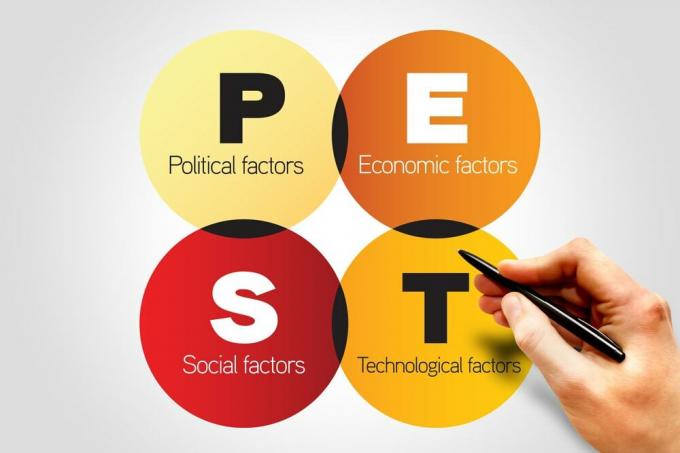PEST analysis can be defined as a description of the business context or environment. It is in it where factors outside but close to it are identified and developed, as well as the influence they exert on them.
The PEST Analysis It is an analysis of the political, economic, social and technological factors in the external environment of the organization, which can affect activities and performance. The name comes from the acronyms in English of Political, Economic, Social and Technological.
This analysis is a simple and effective tool used to assess the current situation of the company and thus identify the main external forces (at the macro level) that may affect the deal. These forces can create both opportunities and threats. The objectives of the PEST analysis are:
- know the external factors that affect the organization;
- identify external factors that may change in the future;
- exploit changes (opportunities)
- or defend against them (threats) better than competitors.

The result of PEST is a comprehensive understanding of the factors surrounding the business.
This analysis is also done to assess the potential of a new market. The general rule of thumb is that negative forces affecting that market can make it more difficult to do business in it.
In this article you will find:
PEST Analysis Variations
The analysis can be expanded to two other factors, the environmental and the legal. In this sense, we would speak of PESTAL analysis, and some may even be more specialized and go a little further when considering other factors. As for example there are the following:
- The industrial factor, in which case we speak of the PESTELI analysis
- The ethical factor, in this case is the PESTALE analysis and
- The demographic factor, which is called PESTALD
Benefits that PEST Analysis brings to an organization
- Its application is very simple, it allows understanding by everyone and teamwork.
- It can be worked in conjunction with other tools such as the SWOT matrix or Porter's five forces.
- It can be used in SMEs and large companies.
How to perform the Pest analysis?
It is not a complex task. To carry out the PEST analysis, it only requires the participation of a multidisciplinary team that is dedicated to observing and identifying the aspects that constitute the business environment and its surroundings. Also, describe each of its characteristics.
Advertisements
This requires that the members of the analysis team prepare worksheets to present their findings. Then share, analyze together, reach a consensus about the negative or positive impacts of each factor on business interests and communicate the results to stakeholders, for example to the board of directors of a business.
The process of carrying out PEST analysis should involve as many managers as possible to get the best results. The following steps should be included as mentioned above:
Advertisements
- The collection of information on political, economic, social and technological changes + any other factor (s).
- Identify which of the PEST factors represent opportunities or threats.
To carry out the Pest (or any other modification of it) managers have to gather as much relevant information about the company's external environment as possible. Today, most information can be found on the Internet relatively easily, quickly and at a low cost. When the analysis is performed for the first time, the process may take a little longer. Questions like "What exactly changes am I looking for in politics, economics, society, and technology?" they will be typical at the time of the studies.
List of common Pest factors to consider
The areas studied by the PEST analysis are: politics, economics, social and technology. Below are some of the aspects that each one evaluates.
Advertisements
They are factors related to the performance of the government of the country where the company is developed and that have the capacity to affect it directly or indirectly. Some of them are:
P - Political Factors
- Change of government and government policy.
- Fiscal, tributary and customs policies.
- Subsidiary policies.
- Internal conflicts and armed conflicts at the international level.
- New laws.
- Variations in trade agreements.
- International agreements.
- Political situation of the country.
By analyzing these and other aspects, companies can develop strategies to prepare for changes, adopt new measures to face and overcome new situations.
Advertisements
Other points to consider:
The stability of the government and possible changes
Bureaucracy
Level of corruption
Fiscal policy (rates and incentives)
Freedom of the press
Regulation
Trade control
Import restrictions (quality and quantity)
Duty
Regulation of competition
Government participation in unions and agreements
Environmental law
Law of education
Anti-Discrimination Law
Copyright, Patents / Intellectual Property Law
Consumer protection and electronic commerce
Employment law
Health and safety law
Data Protection Act
Laws regulating environmental pollution
Advertisements
E = Economic factors
They are factors related to the economic situation of the country and the international framework that have the capacity to affect the company directly or indirectly, some of these are:
- Unemployment rate.
- Economic system.
- Economic crisis.
- Gross domestic product - GDP.
- Duties and taxes.
- Inflation, stagflation and hyperinflation processes.
- Monetary devaluation.
- Distribution channels.
- Confidence in the economy.
- Forms of financing.
- Protectionist policies of the States.
Analyzing these and other aspects of the economic area, it is possible to understand the movement of the market, boost a business, or take measures to prevent losses.
Other points to consider:
The growth rates of a country's economy
Rate of inflation
Interest rates
Exchange rate
Evolution of unemployment
Labor costs
Stage of the business cycle
The availability of credit
The level of disposable income of consumers
Monetary policies
Fiscal policies
Price fluctuations
Stock market trends
S = Social factors
This group of factors is related to the idiosyncrasy and behavior of the inhabitants of the environment close to the company or its potential clients both nationally and nationally international. In this case, it is necessary to consider aspects such as the following:
- Cultures, habits, preferences, beliefs, religions.
- Educational level of the population.
- Fashions, uses and customs.
- Consumer buying pattern.
- Customer opinion.
- Perception of how the company looks.
- Styles and quality of life.
- Purchasing level of potential buyers.
- Social classes.
- Life expectancy.
- Diseases.
- Average number of children per family.
Finalizing the analysis of these factors, a company will be able to adapt its policies to adjust to the taste and preference of its target audience, with which you can ensure higher sales, market positioning, maximize profits and loyalty of your clientele.
Other points to consider:
Health Awareness
Attitudes towards imported goods and services
Attitudes toward work, leisure, career, and retirement
Attitudes toward product quality and customer service
Attitudes towards saving and investing
Emphasis on safety
Lifestyles
Shopping habits
Religion and beliefs
Attitudes towards organic products
Attitudes towards the topic of renewable energies
Growth rate
Immigration rates and emigration
Distribution by age and life expectancy rates
The distribution by sex
Income level
Social classes
Family size and structure
Minorities
T = Technological factors
Last, but not least, is technology, every company must be attentive to new technological advances and adapt them according to their resources and possibilities.
This guarantees a better preparation to face the competition and have a competitive advantage. Among others, it is necessary to analyze:
- Programming.
- New equipment and machinery.
- Artificial intelligence.
- Machine Learning.
- 3d prints.
- Rationalization of energy.
- New energy sources.
- Obsolescence.
- Networks.
- Internet
- Programs and software development in the cloud.
- Technological replacement.
Finally, it is convenient to note that the environment of companies is permanently variable, so they must adapt to these changes. Finally, they should only focus their efforts on addressing the factors that affect their productivity, and avoid concentrating on those that do not have a decisive influence on their operations.
Other points to consider:
Basic infrastructure level
Technological change rate
Research and development spending
Legislation relating to technology
Technology level in the industry
Communication infrastructure
Access to the most advanced technology
Internet infrastructure
Apart from these aspects can be considered in the analysis:
Environmental (ecological)
Climate change
Laws regulating environmental pollution
Air and water pollution
Recycling
Waste management
Attitudes towards organic products
Endangered species
Attitudes towards and supportive of renewable energy
Legal
Copyright, Patents / Intellectual Property Law
Consumer protection and electronic commerce
Employment law
Health Laws
Data Protection Act
Ethical
Ethical advertising and sales practices
Accepted accounting, management and marketing standards
Attitude towards counterfeiting
Ethical hiring practices and employment standards (no use of children to produce goods)
Demographic
Growth rate
Immigration and emigration rates
Distribution by age and life expectancy rates
The distribution by sex
Income level
Social classes
Family size and structure
Minorities
Identify opportunities and threats
Information gathering is only an important first step in making the PEST analysis. Once this is done, the information has to be evaluated. There are many changing factors in the external environment, but not all of them are necessarily affecting or may affect the organization. Therefore, it is essential to identify what PEST factors They represent the opportunities or threats for the company and from this create the list of only those factors that are most influential. This allows you to focus your energies on the key changes that could have an impact on the company.


